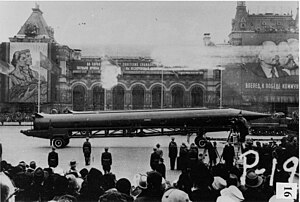Cuban missile crisis
| Cuban Missile Crisis | |||||||
|---|---|---|---|---|---|---|---|
| Part of the Cold War | |||||||
 Soviet R-12 intermediate-range nuclear ballistic missile (NATO designation SS-4) in Moscow |
|||||||
|
|||||||
| Belligerents | |||||||
|
Supported by: |
Supported by: |
||||||
| Commanders and leaders | |||||||
| Casualties and losses | |||||||
| None | 1 U-2 spy aircraft shot down 1 aircraft damaged 1 killed |
||||||
The Cuban Missile Crisis, also known as the Caribbean Crisis (Russian: Карибский кризис, tr. Karibskij krizis), or the Missile Scare, was a 13-day (October 16–28, 1962) confrontation between the United States and the Soviet Union concerning American ballistic missile deployment in Italy and Turkey with consequent Soviet ballistic missile deployment in Cuba. The confrontation, elements of which were televised, was the closest the Cold War came to escalating into a full-scale nuclear war.
In response to the failed Bay of Pigs Invasion of 1961, and the presence of American Jupiter ballistic missiles in Italy and Turkey, Soviet leader Nikita Khrushchev decided to agree to Cuba's request to place nuclear missiles in Cuba to deter future harassment of Cuba. An agreement was reached during a secret meeting between Khrushchev and Fidel Castro in July 1962 and construction of a number of missile launch facilities started later that summer.
The 1962 midterm elections were under way in the United States and the White House had denied charges that it was ignoring dangerous Soviet missiles 90 miles from Florida. These missile preparations were confirmed when an Air Force U-2 spy plane produced clear photographic evidence of medium-range (SS-4) and intermediate-range (R-14) ballistic missile facilities. The United States established a military blockade to prevent further missiles from entering Cuba. It announced that they would not permit offensive weapons to be delivered to Cuba and demanded that the weapons already in Cuba be dismantled and returned to the USSR.
...
Wikipedia
